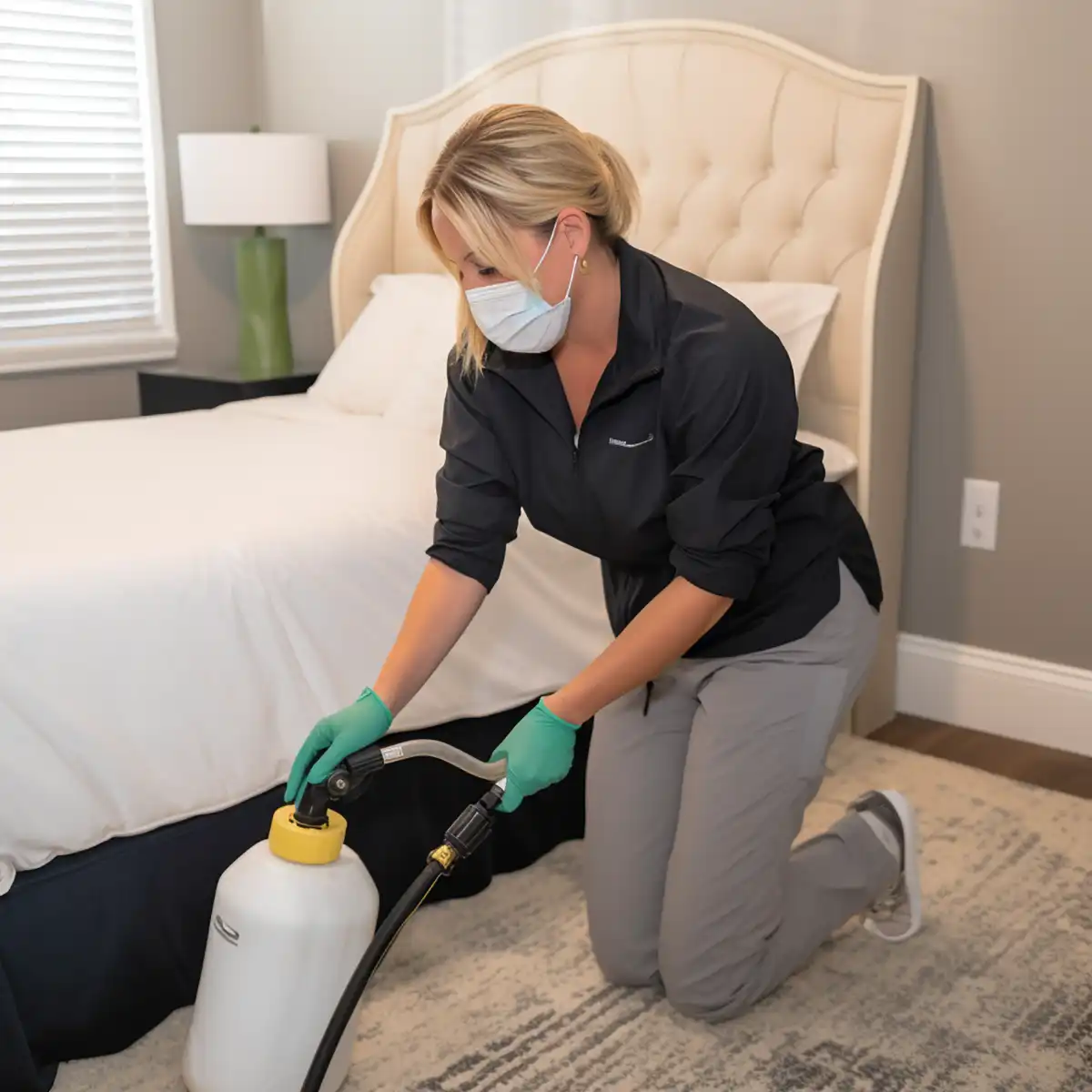How to Get Rid of Bed Bugs
Getting rid of bed bugs is easier and much less scary than you might think. But unfortunately, most people fail because they rush through the necessary steps and don’t perform follow-up treatments.
A common misconception is that hiring an exterminator will make it easy for you. It may be easier to do it yourself! You’ll still be doing all the prep work, which is often the most challenging part of the process. Can you guess who the exterminator blames when treatment doesn’t work? You, and your prep work, so read that contract carefully.

Woman eliminating bed bugs in an infested bedroom.
People have shared their tips on how to get rid of bed bugs with us for over a decade. Drawing on these successes, we’ve put together four steps to help you eliminate this problem for good.
Take time to understand these steps, do them properly, and eliminate bed bugs for good!
1. Prepare for Treatment
Before you can start spraying for bed bugs, you need to prepare. Unfortunately, preparation is incredibly time-consuming, and there is no way around it! If you think hiring an exterminator will make this step easier, think again – they require you to do the same thing, and they’ll make you sign off on that before they start treatment.
Preparation is one of the five things many pest control companies don’t tell you about up-front.
Below is a list of treatment preparation steps you must complete.
Pre-Treatment Preparation List
- All mattresses and box springs must be placed upright against the wall.
- Take apart the bed frame, remove the headboard, and place it against the wall.
- All shelves must be cleared of any objects.
- Clothing must be removed and placed in zip-lock or sealable plastic bags. Separate washable from non-washable items. Non-washable items are to be taken to the dry cleaners and clearly marked for the cleaner to know and deal with the problem. Dry cleaners must be advised that they may not reuse the plastic bags the clothing was brought in. Include everything!
- Empty all dresser and nightstand drawers and remove the drawer from the dresser or nightstand.
- Place all treated, sealed bags in an area that does not require treatment.
- Place the sofa on its side so the pest control technician can access the underside of the sofa area.
- Do not move your furniture into another room unless you are positive you have killed every last bed bug. You don’t want to infest another room.
- Remove electrical wall plates and make sure nothing is plugged into outlets – if you feel uncomfortable doing this, don’t do it and seek help from a professional.
- Remove all items from the base of the closets and place them in a sealed bag.
- Remove all loose items from the floor, which must be moved 12 inches away from the baseboards, including toys, etc.; this includes both the basement and attic. Washable toys are to be handled in the same manner as clothing.
- Remove all paintings, mirrors, and wall accessories from the walls.
- Remove all sheets, blankets, mattress covers, and pillowcases from all beds, wash in HOT (120F) water, and dry at high heat. After cleaning, place them in new plastic bags and do not return them to the bed until after receiving pest control service. Wash or dry clean all pillows.
- If you take your clothes to the laundromat, let the staff know so they can help make sure any bed bugs don’t spread to the next person.
- Vacuum the floors, drapes, and baseboards. Vacuum the cleared closets, shelves, drawers, etc. Remove the vacuum bag outside, tape it shut, and place it in the dumpster.
2. Eliminate Bed Bugs
Many professional exterminators would rather you not know about how bed bug dust. The main ingredient is food grade Diatomaceous Earth (DE), a natural, inexpensive pesticide that you can buy at your local store for less than $25! Unfortunately, many pest control companies rebrand and sell it as an ‘organic’ solution with a ridiculous price markup.
These instructions show you how to make and spray your powder.
See our bed bug inspection tips for a list of places bed bugs like to hide. This is IMPORTANT! You need to get the powder into every nook and cranny; it seems easy, but people forget hiding spots such as screw holes, gaps in baseboards, and cracks in the wall.
3. Bed Bug Control
To eliminate bed bugs in their various stages of development, you MUST retreat your home 3 to 4 weeks after each treatment. Single treatments may kill the adults, but you’re left with another infestation when the eggs hatch.
You must complete this step; your chances of successful bed bug control significantly increase when you retreat. We have a lot of testimonials on what happens when you don’t do a second application.
Some visitors claim they eliminated their infestation in two treatments, but play it safe, save yourself a ton of frustration, and stick with three treatments. If you’re going to all this trouble, you might as well make sure you killed them all.
4. Make sure they don’t come back!
If you did everything right, you successfully killed the bed bugs (good job!), but we still need to take precautions.
Most important is a mattress encasement that covers the entire mattress. Visitors have suggested that getting a mattress cover that protects from dust mites rather than one labeled for bed bug control is just as effective, and you’ll avoid paying extra.
Try to figure out where you picked up bed bugs in the first place; if you suspect a location you frequent, look for the telltale signs, remove your clothes after visiting, and place them in an airtight bag for proper cleaning.
I’m Bed Bug Free!
You can do this – Killing bed bugs is not rocket science!
But,
If you need inspiration, then take a look at these inspirational DIY Testimonials.
